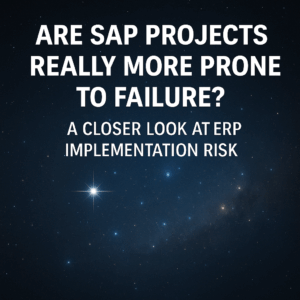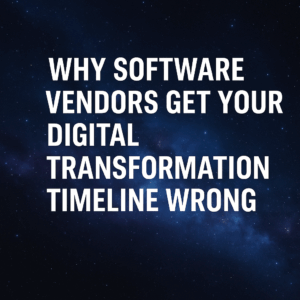Software sales vendors are notorious for misleading current and potential customers in terms of what their digital transformation is going to look like but what exactly are those sales tactics that you should be aware of?
When we look at digital transformation success versus failure part of the reason why digital transformations fail so often is that software sales vendors don’t set realistic expectations for what a transformation is going to look like. Instead, they use sales tactics and sales spin to help portray an overly optimistic picture of what a digital transformation is going to look like using their software.
In this article, we aim to expose the top 10 things that software sales vendors do and say to mislead customers.

Table of Contents
Toggle1 – Silver Bullet

The first misleading sales tactic to be aware of is the concept of the Silver Bullet. It’s a common misconception that there is one silver bullet solution to all of your problems. This phrase suggests an easy fix with no drawbacks, which simply isn’t realistic or achievable in most cases—especially when it comes down to software sales pitches!
The message here should be very clear. Organizations need to understand that software isn’t perfect, and there are always risks in thinking any singular piece can solve all problems for an organization without fully assessing its strengths and weaknesses against potential solutions–especially when it comes at the cost of other more important things like time or money which may not have enough resources allocated towards them already!
2 – Lift And Shift

The second example of a sales tactic to be aware of is the concept of “lift and shift.” Lift and shift is a phrase that’s commonly used to suggest that moving or migrating to a software vendor’s solution is going to be as easy as just moving your current system to the new one and that’s simply not the case.
Understanding that anytime you’re deploying new technology, it involves significant changes to your people and processes and this rollout can be crucial for success. Risk is especially prevalent when upgrading from one vendor solution or platform within today’s environment of cloud computing because there are so many factors involved in making this transition smooth without complications down the road.
3 – The “Yes, our software can do that!” Claim
Software is complicated. It’s not just a yes or no decision of whether the function can be executed, but more so an objective range in terms of how well it will handle certain functions and its ability compared to other systems out there today.
The key here is when looking at quantitative data, which helps mitigate risk while assessing subjective qualities like simplicity for example; determining if something has potential by seeing what works best within your company culture – all these things should go hand-in glove! Independent advisors can also help to navigate this narrative and bring an understanding of the true capabilities of the system.
So when your vendor says YES to your inquiries, I suggest digging deeper to understand what that really means for your business.
4 – Best Practices

“Best practices” is a term used often in the software industry. This concept has been defined in many different ways by various software sales vendors, but there’s no such thing as one single set of ‘best’ approaches because each company needs to tailor its process based on what they specifically want out of the system.
This is a tricky subject because the term “best practices” gets thrown around way too much. It’s not necessarily about which software has proven itself as being better, but more so how they work in your business and what you need from them.
5 – Cloud Costs Are Cheaper Than On-Premise Costs

Cloud technology is often marketed as cheaper than on-premise solutions, but in reality, this idea doesn’t hold up. It’s important to know that there are certain areas of cloud deployment which may be more affordable and others where you might save money by going with an offsite storage strategy; however, the long-term costs will likely vary between providers depending upon what features they offer. Cloud tech is rarely a more affordable option.
We’ve seen it time and again with clients, that for every dollar they save on say not having to maintain internal servers or have as much of an I.T staff supporting legacy systems, you are shifting those costs onto the vendor who will be paying more in ongoing annual expenses than before. The idea that you will save money by deploying Cloud technology is typically not true.
So when you hear your software sales vendor say that the cloud costs are less than on-premise or other types of technology, really take that with a grain of salt and dig in and understand what the total cost of ownership is before you believe that statement.
6 – Technology Overkill
Another sales tactic to be aware of is technology overkill. In the software industry, there are a lot of really cool bells and whistles that modern technology offers. That being said, most companies don’t need all these features at once, which means you might end up overpaying for something your company won’t use or even understand how to use! Be wary if a software sales vendor tries selling you on too much unnecessary tech.
It’s on you to understand your business needs, requirements, and priorities to make sure that you’re finding and acquiring the right software and the right amount of software without over-committing to a bunch of software that you may not be used in the future.
7 – Integrated Solutions
The common sales messaging for enterprise-wide technology is that the solutions are fully integrated. We would argue this isn’t always true and there are advantages to having multiple modules within an ERP system instead of one big integration project.
As we’ve seen before, typically the systems don’t come out of the box as an integrated solution. You have to do some work yourself for each part to integrate and function properly. Oftentimes this means going one step further with software vendors who provide third-party bolt-ons which can be purchased individually or bundled depending on the overall product experience.
So, when told that a system comes fully integrated, make sure you do your due diligence and find out what that means specifically for your business.
8 – Implementation Complexity and Risk
With so many companies vying for technological advantage, software sales vendors are often forced to make optimistic assumptions about how quickly their innovations can be adopted. The unfortunate reality is that this typically leads project managers down a path of optimism bias where they underestimate the time needed for adoption by different parts or levels within an organization.
There are two different implementation plans and two different implementation budgets.
Typically the software sales vendors and the sales reps are selling you on the first scenario which is to deploy technology, so be sure that when you’re looking at proposals from software vendors and or system integrators, you’re adding a dose of reality to those proposals. You will need to look at things like data migration and system architecture, change management, process improvement etc.
It is crucial to understand the full cost of a new system before committing. The price for an entire project usually does not include all its components, and these can be critical in determining if it’s worth your time or money–or both!
9 – “The A-Team”
Software sales vendors and their implementation partners commonly use a sales tactic called “The A-Team.” This is team is made up of the best possible resources the vendor has available, which the vendor will provide to you and you alone. At least that’s what they would like you to think.
To be fair, some software sales vendors and system integrators do offer the best of their resources to customers. However, it can also mean that other members in these organizations aren’t as capable or skilled which might explain why they’re giving you such an elite team member status with “The A-team.”
Just as you would any other contractor or internal resource, it is important to vet your vendors so that the team best fits what YOU need for YOUR transformation.
10 – Agile Implementations

The concept of agile implementations has been used to mislead businesses into thinking that they can effectively manage their budget, timeline, and other aspects during a digital transformation. However, this is not true as many projects end up with unfinished tasks or updated estimates based on wrong assumptions which lead to the original problem statement – overspending on your transformation project!
One of the challenges with agile project management is that it can run counter to enterprise-wide technology rollouts. Agile would suggest that you start deploying faster and start getting technology in the hands of users so that they can provide feedback and you can pivot and adjust that software to fit your future state. That’s very inconsistent with the common business process model that you might be trying to accomplish if that is your goal. That’s just one example of how agile runs counter to the goals and objectives of digital transformations.
Be leery of the term agile, we are not suggesting you fully reject agile but to ensure that you use it selectively throughout your digital transformation
It turns out there is no such thing as one-size-fits-all when it comes down to transforming an entire company. We wanted to share our observations from working closely alongside companies throughout the years – these 10 tips can help guide decision-making around software purchases and implementation strategies.
I’d also highly recommend downloading the 2023 Digital Transformation Report which is packed full of industry insights and best practices.





